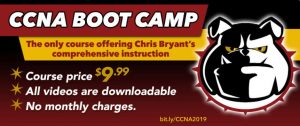CCNA 200-125 And 200-301 Practice Exam: OSPF Fundamentals
Whether you’re working on the CCNA 200-125 or 200-301 exam, this OSPF practice exam will really come in handy.
By the way, I guarantee you’ll beat the February 2020 CCNA 200-125 deadline with my CCNA Flash Cards, or you get the 200-301 set absolutely FREE.
Check it out when you’re done here. Let’s have at it!
Question 1:
If the router on the right already has an entry for the 172.12.23.0 /27 network, how will it react to the incoming LSA?

A. It will ignore the incoming LSA.
B. It will accept the incoming LSA unconditionally.
C. The incoming LSA will be accepted if the sequence number of the incoming LSA is lower than that of the LSA entry already in the router’s database.
D. If the incoming LSA has a higher sequence number than that of the LSA entry the router already has, the LSA will be accepted. Otherwise, it’ll be denied.
Question 2:
What is the difference between the administrative distance of a route OSPF learns about via the network command as opposed to a route learned via route redistribution?
A. They’re exactly the same.
B. The route learned via network will have a higher AD than that of the other route mentioned.
C. The route discovered via route redistribution will have the highest AD of the two routes.
D. Without knowing the seed metric of the two routes, it’s impossible to tell.
Question 3:
Which of the following must potential OSPF neighbors agree upon in order to become actual neighbors?
A. Area number
B. The hello and dead timer settings
C. Whether the area the adjacency will be created in is a stub area
D. All of these
E. None of these
Question 4:
The output of which OSPF-related command is shown below?
Serial0/1/0 is up; line protocol is up Internet Address 172.12.123.1/24, Area 0 Process ID 1, Router ID 1.1.1.1, Network Type NON_BROADCAST, Cost: 64 Topology-MTID Cost Disabled Shutdown Topology Name 0 64 no no Base Transmit Delay is 1 sec, State DR, Priority 1 Designated Router (ID) 1.1.1.1, Interface address 172.12.123.1 No backup designated router on this network Timer intervals configured, Hello 30, Dead 120, Wait 120, Retransmit 5 oob-resync timeout 120 Hello due in 00:00:23 Supports Link-local Signaling (LLS) Cisco NSF helper support enabled IETF NSF helper support enabled Index 1/1, flood queue length 0 Next 0x0(0)/0x0(0) Last flood scan length is 1, maximum is 1 Last flood scan time is 0 msec, maximum is 4 msec Neighbor Count is 2, Adjacent neighbor count is 2 Adjacent with neighbor 2.2.2.2 Adjacent with neighbor 3.3.3.3 Suppress hello for 0 neighbor(s)
A. show ip ospf neighbor
B. show ip ospf
C. show ip ospf interface
D. show ip ospf database
Coming up next, after this very brief advertisement for my CCNA 200-125 Video Boot Camp, we’ll get to the answer discussion!
Told you it was brief! Let’s get to those answers…
Answer 1: D. The router receiving the LSA will check the sequence number of that LSA against the one already in its OSPF database for that particular route. If the sequence number of the incoming LSA is higher, the router will add that LSA to its database, send an LSA ACK to the sender. The router will also flood that LSA and update its own routing table by running the SPF algorithm against the now-updated database.
Answer 2: A. The AD of a route learned by OSPF via the network command or via route redistribution is exactly the same — 110. (In EIGRP, those ADs would be different.)
Answer 3: D. For OSPF-enabled routers to form an adjacency, they must agree on the area number through which the adjacency will be created, along with the “stub status” of that area (yes or no) and the OSPF dead and hello timers.
Answer 4: C. That’s the very helpful output of show ip ospf interface. If you specify an interface with that command, such as show ip ospf interface serial 0/1/0, only the info for that interface will be shown. If you don’t specify an interface, you’ll get that information for every OSPF-enabled interface on the router. Since I didn’t give show ip ospf int serial 0/1/0 as a choice, the only correct answer is show ip ospf interface.
Make every study minute count with my CCNA Flash Cards, and I’ll see you tomorrow with a new CCNA practice exam!
Chris B.






